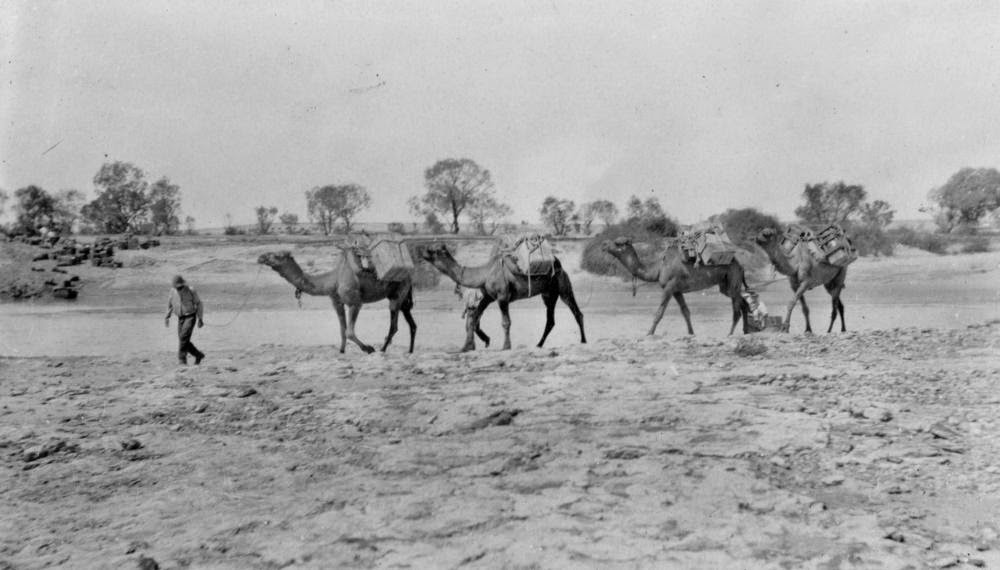
Colonial, Pastoralism, Agriculture
and Mining Nomenclature
There are a series of waterholes which were named Hergott Springs by John McDouall Stuart after the German botanist, Herrgott, who accompanied him in 1859. Herrgott had also been a member of B.H. Babbage’ exploring party to the west of Lake Eyre and Lake Torrens. in 1858.
Proclamation
In 1883 a township was surveyed at the end of the railway extension and named Hergott Springs and proclaimed as such by a proclamation in the ‘South Australian Government Gazette’ of 20. December 1883.
When the post office was opened in 1884 the postal authorities used the term Hergott Springs Post Office.
Sometime between 1901 and 1911 Hergott Springs became accepted as the official name of the town. It is shown thus (and not as Marree) in the 1911 census.
Hergott Springs, together with other German-sounding names in Australia, was altered by Act of Parliament during World War I. The new name adopted for the town was Marree. Hergott Springs Railway Station was altered to Marree, as was also the name of the post office.
Mr Norman B. Tindale, anthropologist at the South Australian Museum wrote on June, 26th 1955:
‘According to the Reuther manuscript the native name [of the springs] is Marina or Mari, this means “place of opossums”. According to the Tirari tribe an ancestral being named Papapapana discovered the Hergott Springs and noticed many opossum tracks running away from it and so gave it that name. Mr Reuther was a missionary at either Kopperamanna or Killalpaninna mission station in the early part of this century [20th century]. His voluminous notes are now in the South Australian Museum and for the most part have been translated.’
Pastoralism
The Lake Eyre region is the driest land and region in Australia, yet has many waterways scattered with waterholes and mound springs. By the mid 1880’s, many settlers had taken up pastoral leases in the area, taking advantage of the water sources. Soon after construction of the Telegraph many properties were settled. By the late 1880’s sheep and cattle were both grazed but now cattle produce most of the agricultural income from this area.
Anna Creek, one such pastoral property, is the largest cattle property in Australia (and possibly the world) and formerly a Kidman property but recently purchased by the Williams Cattle Company. Muloorina was originally established as a camel farm in 1904 by the SA Government, but closed down in 1929 as the demand for camel transport diminished. Elliott and Stan Price bought the land in 1936 and expanded it to become the property that visitors now pass through on the way to Level Post Bay at Kati Thanda-Lake Eyre.
Stock route from Marree to Birdsville
This route came into use in about 1880. A ‘Memorandum Re Water Supply from Hergott to Birdsville’, published as Parliamentary Paper No. 189 of 1885, makes it clear that the government had recently spent money on dams and wells.
Cultivation of the Date Palm
On 1 October 1883 James William Jones was appointed Conservator of Water (under the Commissioner of Crown Lands and Immigration). The following is a report by him, which is headed ‘Experimental Garden at Hergott’:
‘This garden was planted to prove whether the water flowing from the artesian bores in this locality is fit for irrigation, and the result has been, on the whole, satisfactory, the rest trees, notably the sugar gums, are doing well. Dates appear to thrive. Some garden products, such as melons, tomatoes, raddish, turnins, and also mangolds (some weighing 14 lbs), sunflower, rape, canary seed and even lucerne, oats and wheat have been successfully grown. The trees and plants are watered from ditches carrying the overflow water from the bore. A few vines and fruit trees and some additional forest trees have been planted this season.
£29 was received during the year from sales of melons, tomatoes, etc. grown on small plots in the Garden. In a report on the operations the man in charge (a practical gardener) says – “With the general results of the experiments I feel justified in saying that vegetation can be grown successfully with the bore water and with better results than yet obtained”.
This applies to the Hergott bore, the water from which is better quality than the Coward, Strangways and other artesian wells in this particular locality.’
The Central Australian Railway
The Central Australian Railway was built through this area in the late 1880s.
The railway from Farina to Hergott was authorised by Act 226 of 1881 (assented to on 18 November 1881). The guage was to be 3 feet 6 inches, and the rails were to be of steel weighing not less than 50 lbs to the yard. The maximum speeds allowable were 20 miles per hour for good trains.
The line was opened on 7 February 1884.
The Central Australian Railway concept was to link Darwin and Adelaide, although it may also have started from pressure by farmers to service northern areas of South Australia for wheat growing. The line was opened to Oodnadatta on January 1st 1890, and freight was carried north by camel train for many years until 29th August 1929, the line to Alice Springs was completed.
Water was one of the main concerns with sighting the line, as was the case with the telegraph, so it is not surprising they took similar routes. Eventually the telegraph line was moved closer to the railway line, making repairs easier. Water also caused the ultimate closure of the railway, as flash floods caused great damage and maintenance was too expensive. On some rivers, low- level bridges proved to be superior to high – level bridges as debris from floods tended to flow over low- level causeways instead of building up against bridge – work which could damage high – level bridges. Both types were built on the Finke River, but it was found to be more efficient to simply rebuild the line in the river bed each time it washed away. Diesel locomotives replaces steam engines in 1954 and many water points then fell into disrepair. The line was closed in 1982 and the last train rolled out of Marree in 1986.
